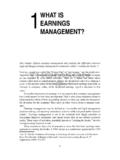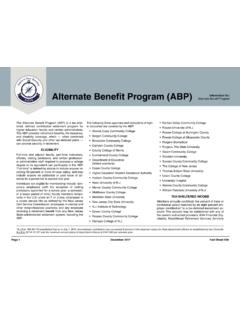Transcription of Pensions at a Glance 2017 - OECD
1 Pensions at a Glance 2017 How does GERMANY compare? Key findings Germany has been the top performer in lifting employment rates of older workers since the turn of the millennium (+30 percentage points in the age group 55-64 since 2000). Working longer may help to improve financial sustainability of the pension scheme and retirement income adequacy. The recently introduced law Flexirentengesetz allows individuals to adapt their career end to individual needs. This legislation may lead older workers to remain in the labour market for a longer time, but recent studies suggest that it might be mostly used as a partial early retirement scheme.
2 The legislation implementing an early retirement option at full pension for people with long working lives ( Rente mit 63 - which, in the future, will provide a full pension at the age of 65 rather than 67) provides little incentives to extend the career beyond 45 years. German women today suffer from the largest gender pension gap among OECD countries (46%); an above average gender pay gap and the large share of women working part-time mean that future pension entitlements of women are likely to continue lagging behind those of men. Net replacement rates of future retirees are expected to remain below the OECD average, in particular for low earners 55% vs.
3 73% at half of average earnings (51% vs. 63% for average earners). Missing basic and minimum Pensions mean that retirees with low incomes rely on the old-age safety net which is comparatively low at 20% of average earnings; this may raise retirement income adequacy concerns for people with low incomes and partial careers. Rapid population ageing will challenge the financial sustainability of the public pension scheme. Under current legislation, public pension expenditures are expected to rise from about 10% of GDP today to in 2050. Overview Flexible retirement as a remedy for labour shortages?
4 Pensions are high on the German policy agenda. 18% of respondents to a Eurobarometer survey indicate that it belongs to the two most important current issues faced by the country, compared to only on average among 22 EU countries, with rising attention over the last decade. Germany s economic prosperity has created strong labour demand in recent years and employment rates have increased substantially, in particular for older age groups. However, the rise in labour demand comes at a time in which baby boomers reach their career end and younger generations increasingly enter tertiary education, leading to labour shortages in some occupations, in particular, those requiring medium-level education.
5 Continued population ageing is expected to aggravate labour shortages in the future which, among other measures, calls for policies setting incentives for longer working lives. The recently introduced law Flexirentengesetz broadened the range of retirement options before and after the normal retirement age and thus allows individuals to adapt their career end to individual needs. This legislation may enable older workers to remain employed longer if other factors like health and working conditions allow, but recent studies rather suggest it might act as a partial early retirement scheme resulting in older workers cutting back labour supply early by working shorter hours.
6 While this may correspond to people s preferences, the wider question is of course how to keep labour supply sufficient in light of population ageing. Concern about Pensions has risen considerably in Germany % of respondents answering that Pensions are among the 2 most important issues faced by the country Source: European Commission (Eurobarometer). Contacts: Christian Geppert (+33 1 45 24 92 46; Boele Bonthuis (+33 1 85 55 45 08 ; Rente mit 63 will leave little incentives in the future to extend the career beyond 45 years Impact on annual benefits when working and deferring Pensions by up to 3 years after the normal retirement age, full-career average earner Source: OECD pension models.))
7 See [Figure ]. Moreover, the legislation implementing an early retirement option at full pension for people with long working lives ( Rente mit 63 which, in the future, will provide a full pension at the age of 65 rather than 67) provides little incentives to extend the career beyond 45 years because the deferral bonus of 6% is only applied after age 67. As a result, pension benefits increase rather little in case of continued work; only 2% for the 46th year of work or about 4% annually in case of 48 years of work. These bonuses are low compared to other countries.
8 For example, benefits in Austria rise by almost 8% for the 1st year of work after the eligibility for a full pension has been reached and more than 8% annually in case of working 3 more years. In Portugal, working longer yields even more than 13% higher pension benefits per year of retirement deferral. Germany s future pensioners face comparatively low net replacement rates - 51% for the average earner which is well below the OECD average of 63% (under current legislation). Low earners, at 50% of average earnings, fall even more behind their peers in other countries; with a net replacement rate of 55% compared to the OECD average of 73%.
9 One reason is that the lack of basic and minimum Pensions means there is little redistribution in monthly pension benefits. Moreover, marked life expectancy gaps between high and low income earners, amounting to several years, effectively turn the system even regressive from a lifetime perspective as richer individuals receive pension benefits on average over a substantially longer retirement spell. Rapid population ageing will challenge the financial sustainability of the public pension scheme. Under current legislation, public expenditures on Pensions are expected to rise from around 10% of GDP today to in 2050, limiting the scope for social policies.
10 Moreover, Germany has experienced a marked increase in wage inequality in recent decades. The tight link between wages and benefits in the pension system is expected to transmit the rise in wage inequality into higher pension inequality in the future (OECD 2017 - Preventing Ageing Unequally). In particular certain groups, like single parents with interrupted careers and low-educated, low-paid workers will be at risk of old-age poverty. The risk is particularly high for German women who today suffer from the largest gender pension gap among OECD countries (46%); an above average gender pay gap and the large share of women working part-time mean that future pension entitlements of women are likely to continue lagging behind those of men.















